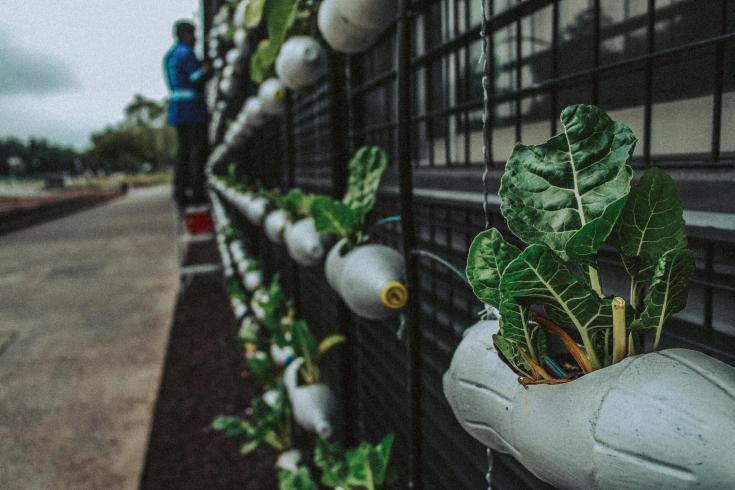Reuse and repair centres: moving out from the shadow of recycling

Waste prevention is the most efficient way to improve resource efficiency and to reduce the environmental impact of waste. The Waste Framework Directive underlines the importance of appropriate measures to prevent waste generation and encourages amongst others the increase of the lifespan of products and the promotion of re-use including through the establishment and support of re-use and repair networks, such as those run by social economy enterprises.
The development of reuse and preparing for reuse centres also leads to the creation of local green jobs and enables training people that are distanced from the labour market such as long-term unemployed, low skilled workers, persons with disabilities, ex-prisoners and people who have struggled with addictions. RREUSE, the European Network of social enterprises in reuse, repair and recycling, estimates that preparing for re-use of just 1% of municipal waste generated in Europe could help support 200,000 local green and inclusive jobs.
Nevertheless, despite the efforts at European and national level thus far, the amount of waste generated is not going down. Annual waste generation from all economic activities in the EU amounts to 2.5 billion tonnes, or 5 tonnes per capita a year, and each citizen produces on average nearly half a tonne of municipal waste. The decoupling of waste generation from economic growth will require considerable effort across the whole value chain and in every home.
Reuse and repair centres
For the INTHERWASTE project partners, reuse and repair centres turned out to be a highly relevant aspect of waste prevention as they support cities in both improving bulky waste management and in enhancing their transition towards a circular economy.
To study how bulky waste can be given a second life, project partners from Krakow (Poland), Porto (Portugal) and Tallinn (Estonia) travelled to Nice in Southern France in October 2018 and visited the brand-new recycling centre in Les Moulins District. During the visit, the participants learned that the bulky waste collected in the District is first separated into reusable and non-reusable waste. The reusable waste is then repaired and exhibited to citizens, who can buy the products at affordable prices or in exchange of other items they bring. In the first months of operation, 80 tons of bulky waste have been collected, of which 5 tons have been transformed into 900 products for resale or exchange.
The recycling centre also serves a wider social purpose and employs people who have difficulties in the labour market. Nine out of 12 workers on the site are employed temporarily through an integration programme, providing them with the opportunity to gain confidence in their capabilities of finding a job. Moreover, the centre also serves an educational function spreading awareness around environmental issues.
Image source: www.urban-waste.eu
Reuse centres for each recycling station in Tallinn
Estonia’s capital Tallinn took back inspiration from the visit to Nice and introduced two new actions in its Municipal Waste Plan: giving bulky waste a second life by creating reuse and resale centres near city civic amenity sites and working out a mobile clean point system to collect from households hazardous wastes. In December 2018, the funding for the two actions was approved by Tallinn City Council and added to the Tallinn Enterprise Department budget. Accordingly, a total of 150,000 Euros has been made available during 2019-2020 to redesign the functions of three existing household waste recycling centres:
- A warehouse in Pääsküla recycling station has been put into operation as a reuse station
- Paljassaare recycling station has been renovated in 2019 and now features storage rooms for reusable items
- Mustjõe recycling station will soon be open with storage rooms for reusable items.
The solution is beneficial for both residents, who can now purchase reusable household items for a symbolic fee (e.g. furniture; books; etc.) and for the organisers, because they manage to give a second life to reusable objects. Tallinn Waste Plan foresees creating a reuse point in every recycling centre of the city in order to increase the number of reused items and to reduce the amount of bulky waste.
Planning reuse and repair in Krakow
The Municipality of Krakow was also inspired by Nice’s recycling centre 'Les Moulins' and decided to build a repair and reuse point in Krakow thus allowing the city to prioritise waste prevention and to upgrade its waste management system.
To this end, the city proceeded with a study to analyse 'The possibility of implementing a repair point and reuse of products in the Municipality of Krakow'. As a result, it is planned to realise the project in the timeframe 2020-2025 with an estimated cost of 345,000 Euro. The city established that it is possible to co-finance the costs by the Regional Operational Programme for the Małopolska Voivodeship and European Assistance funds under the Operational Programme Infrastructure and Environment.
Conclusion
Waste prevention and preparation for reuse activities are higher on the waste hierarchy than recycling and can also create more jobs compared to other waste treatment options, including jobs for disadvantaged groups. This INTHERWASTE good practice for a reuse and repair centre has inspired several partners to implement similar activities and could be of interest to regions and cities that are keen on implementing waste prevention measures as required by the Waste Framework Directive.
